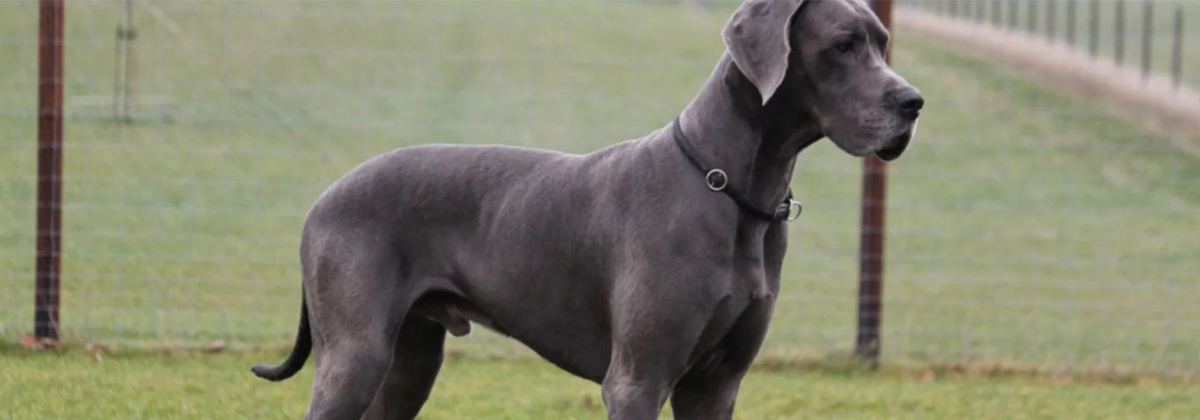04 Apr Different Facts About the Great Dane (Part 1)
If you are one of those people who are interested in keeping big dogs; the Green Dane dog is a good choice for you. This dog is known as the German Mastiff, too. The Green Dane is kind and gentle. He also has great grandeur and power. Of course, training and keeping this dog is a little more special than other breeds. In this article, we’re going to introduce you to the background, appearance, temperament and how to care for and maintain them.
The Great Dane background
Paintings of Great Dane found in Egyptian monuments and Chinese literature show that the ancestors of this breed existed thousands of years ago. However, in appearance and behavioural characteristics, he’s different from today’s breeds. Some believe that the Great Dane breed is a combination of the Mastiff and Irish Wolfhound breeds and was born in Germany because of his strength, intelligence and resilience to hunt European boars, and German nobles used the dog as a guard or as a friend and companion.
The Great Dane was declared the German National Dog in 1876, and in 1891 the Deutsche Dogge Club adopted an official standard for describing the breed. Finally, in 1887, he was recognized by the American Kennel Club as a member of the working group. The Great Dane was nicknamed the “Apollo of dogs” because of his importance and power. Apollo is one of the most important Gods among the Greeks and has a higher status than other Gods. That’s why giving this title to Great Dane. Today, this dog is used much less than before to hunt wild boar and is known as a warm-hearted, compassionate and adaptable breed. Great Dane is a brave, lively dog with friendly and reliable behaviour, and his combination with his large and powerful appearance makes him unique and unlike any other breed.
Great Dean, a beautiful and purebred dog
From the appearance of the Great Dane dog, we can mention the shiny black round eyes, long neck and legs, round paws, medium and standing ears, and long conical tail. Great Danes are one of the largest dogs in the world that have a muscular body with shaved limbs and a rectangular head and body. Their body covering is short, thick and shiny and has a wide range of colours (for example, gray, piebald, spotted, brownish yellow, black, white with irregular black and gray-black spots, etc.). The most famous colour of Great Dane is black and white, known as “harlequin”.
Height and weight
- Adult Green Danes are 81 cm or taller and females are about 76 cm or taller.
- Male Great Dane weighs 60 to 90 kg and females weigh 45 to 60 kg.
- Due to their beauty and fitness, Great Dane dogs are used to dog shows. However, if the male Great Dane is less than 76 cm and the female less than 71 cm, they will be disqualified.
Great Dane Dog; A shrewd dog
Great Dines are inherently trustworthy guard dogs for large homes and villas. But they shouldn’t be encouraged to guard a lot, as they may become aggressive.
Behavioural characteristics
These dogs are strong, stubborn, sensitive, trainable, obedient, calm, playful, extremely kind, happy friends and companions. Dog breeders and trainers believe that aggressive or frightening behaviour in Great Dane dogs is due to their poor breeding and training. The great thing about this dog is that even if he’s very well trained, you shouldn’t leave him alone with children. Because he’s inherently strong and playful. On the other hand, be sure to teach children how to interact well with them.
Keeping a Great Dane dog
Young Great Dane dogs are energetic and perform movements such as running, jumping, jumping up and down with pleasure. Therefore, this dog needs daily exercise and activity, such as regular walking with training. They’re prone to joint and bone disease, so they shouldn’t over-run or exercise during the first year or two of their lives. This breed likes to live with humans and prefers to be indoors rather than outdoors. But if you plan to keep them outside the house, you should consider a safe and enclosed area up to about 2 meters for them. These dogs love to chase and usually follow small animals such as cats and rabbits. The best place to keep this dog is a space between inside and outside the house, with a soft mat and enough space for their activity and play.




Sorry, the comment form is closed at this time.